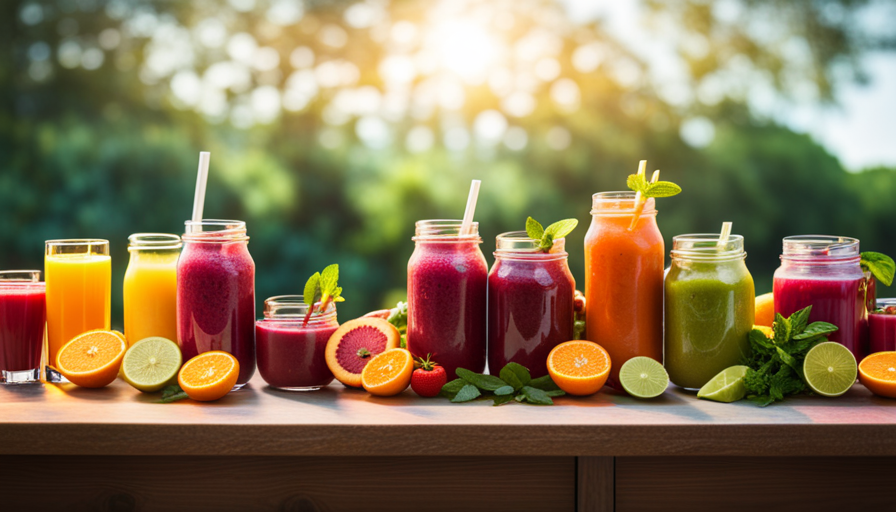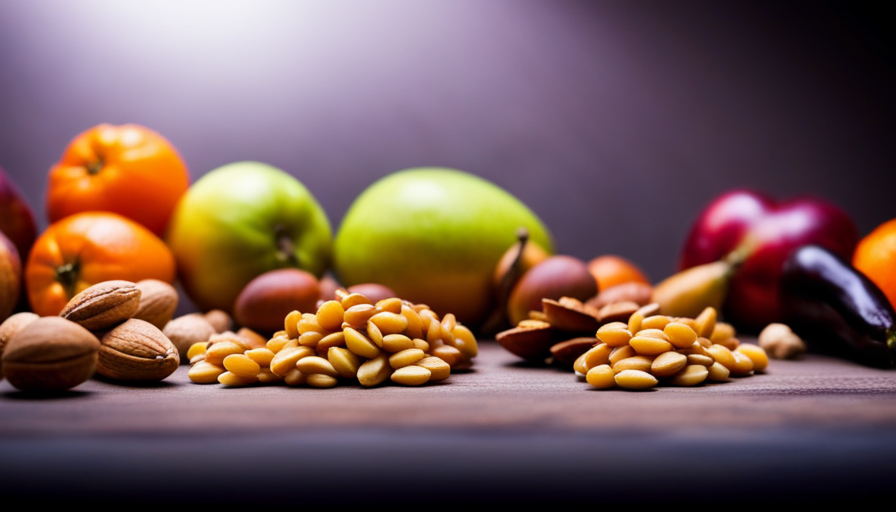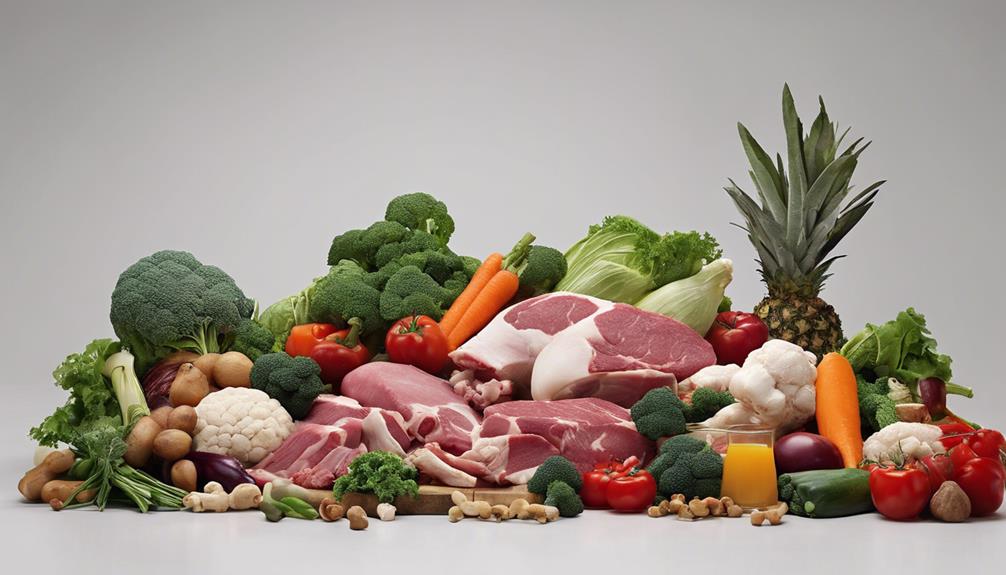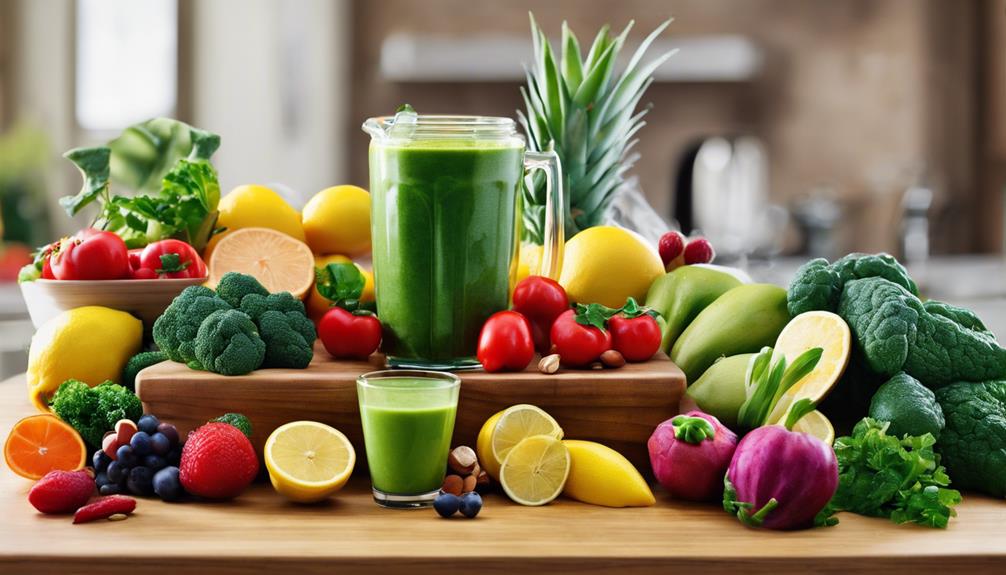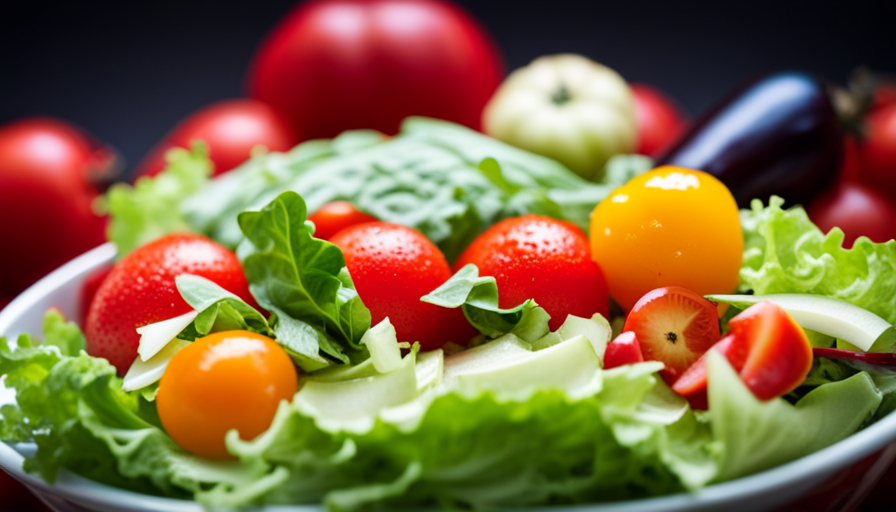During the cold winter months, raw food enthusiasts can still enjoy their plant-based diet. Despite the chill, there are many tasty and nutritious choices available for those who opt for raw foods.
In fact, studies have shown that the consumption of raw foods can provide numerous health benefits, including increased energy levels and improved digestion.
So, what do raw food people eat in winter? Well, they get creative with hearty raw soups and stews, indulge in winter salad varieties, sip on raw warm beverages, and enjoy raw comfort foods. They also incorporate sprouted grains and seeds into their diet, whip up raw winter smoothies, indulge in raw chocolate treats, and spread raw nut and seed butters on their favorite snacks. And let’s not forget about the delectable raw winter fruit desserts!
In this article, we will explore all these mouthwatering options and show you how you can stay warm and satisfied while following a raw food lifestyle during the winter season.
Key Takeaways
- Raw food enthusiasts can enjoy a variety of winter-friendly dishes such as raw soups, stews, and salads.
- Warm beverages like herbal teas and hot chocolate alternatives can be enjoyed by raw food people during the winter months.
- Sprouted grains and seeds are a nutritious addition to raw winter meals, providing vitamins, minerals, enzymes, and fiber.
- Raw chocolate treats and fruit desserts offer delicious and healthy options for raw food people to satisfy their sweet cravings during winter.
Hearty Raw Soups and Stews
Get ready to warm your soul with some delicious and nourishing raw soups and stews that’ll keep you feeling satisfied all winter long! Contrary to popular belief, raw food enthusiasts can still enjoy comforting and hearty dishes during the colder months.
There are plenty of raw winter soup recipes and warming raw stew ideas that won’t only provide you with essential nutrients but also keep you cozy.
One popular raw winter soup recipe is the creamy butternut squash soup. It’s made with raw butternut squash, cashews, and warming spices like cinnamon and nutmeg. This soup is both creamy and comforting.
Another option is the raw tomato soup, which combines fresh tomatoes, basil, and a touch of olive oil for a burst of flavor.
For those looking for a heartier option, raw vegetable stew with a variety of crunchy vegetables and a flavorful raw tomato sauce can be a perfect choice.
These raw soups and stews are packed with vitamins, minerals, and enzymes that can help support your immune system and keep you feeling energized throughout the winter.
Now, let’s transition into exploring the wide array of winter salad varieties that’ll add freshness and crunch to your raw winter diet.
Winter Salad Varieties
During the colder months, raw food enthusiasts can enjoy a variety of delectable salad combinations to savor the winter season. Winter salad recipes offer a fresh and vibrant alternative to the hearty soups and stews commonly associated with this time of year. Incorporating raw fruits, vegetables, and nuts into salads not only provides a burst of flavor but also offers numerous health benefits.
-
Nutrient-rich ingredients: Winter salads often include nutrient-dense fruits and vegetables such as kale, spinach, pomegranate, and citrus fruits. These ingredients are packed with vitamins, minerals, and antioxidants, which can help boost the immune system and ward off winter illnesses.
-
Seasonal variety: Winter salads allow for a diverse range of flavors and textures. From crisp apples to crunchy nuts and creamy avocado, the combinations are endless. Incorporating seasonal produce also supports local farmers and ensures the freshness of the ingredients.
-
Hydration and digestion: Raw foods tend to have a higher water content, which can aid in hydration during the dry winter months. Additionally, the fiber in raw fruits and vegetables promotes healthy digestion and can help alleviate common winter digestive issues.
Transitioning into the subsequent section about ‘raw warm beverages’, we can explore how these comforting drinks can complement the winter salad experience.
Raw Warm Beverages
When it comes to raw warm beverages, there are a few options that I find particularly satisfying. Hot herbal teas and infusions are a great choice, offering both warmth and a variety of health benefits.
Additionally, there are nutrient-rich hot chocolate alternatives that can provide a comforting and indulgent treat without sacrificing the raw food principles.
Hot Herbal Teas and Infusions
Sipping on warm herbal teas and infusions is a cozy way for raw food enthusiasts to stay nourished during the winter months. Not only do these hot beverages provide comfort, but they also offer a range of health benefits.
Herbal teas are known for their medicinal properties, such as promoting relaxation, improving digestion, and boosting the immune system. Homemade infusion recipes allow raw food enthusiasts to get creative by combining different herbs, spices, and fruits to create unique flavors and maximize the nutritional content.
Some popular herbal tea options for winter include chamomile, ginger, and peppermint. These teas can be enjoyed on their own or mixed together for a delightful blend.
As we transition into the subsequent section about nutrient-rich hot chocolate alternatives, it’s important to explore the various options available to raw food enthusiasts during the winter months.
Nutrient-Rich Hot Chocolate Alternatives
Indulge yourself in a warm and nourishing cup of nutrient-rich hot chocolate alternatives to satisfy your cravings and boost your well-being this winter season.
While traditional hot chocolate may contain processed ingredients and added sugars, there are plenty of nutrient-rich options available for those following a raw food diet. One popular choice is a warm almond milk-based hot chocolate, made with raw cacao powder, a natural source of antioxidants and minerals.
Another option is a creamy coconut milk hot chocolate, which provides healthy fats and a hint of tropical flavor.
For a spicy twist, try a hot cayenne-infused chocolate elixir, known for its metabolism-boosting properties.
These warming raw beverages not only deliver delicious flavors but also offer a range of health benefits.
Transitioning into the subsequent section about ‘raw comfort foods’, let’s explore some hearty and satisfying options to keep you warm and nourished throughout the winter months.
Raw Comfort Foods
Craving warmth and comfort during the winter months? You can still enjoy hearty and satisfying meals that nourish your body and soul, even without cooking. Here are three raw warming spices for winter dishes that will add flavor and depth to your meals:
-
Cinnamon: This aromatic spice not only adds a cozy flavor to your dishes, but it also helps regulate blood sugar levels and boost your metabolism. Sprinkle some cinnamon on your raw apple crumble or add it to your morning smoothie for a comforting winter treat.
-
Ginger: Known for its warming properties, ginger adds a spicy kick to your raw dishes. Grate some fresh ginger into your raw carrot soup or mix it into your raw chocolate truffles for a warming and invigorating flavor.
-
Nutmeg: With its rich and earthy flavor, nutmeg is a perfect addition to your raw winter desserts. Sprinkle some nutmeg on top of your raw pumpkin pie or add it to your raw hot chocolate for a comforting and indulgent treat.
By incorporating these raw warming spices into your winter dishes, you can create delicious and satisfying meals that will keep you cozy and nourished.
Now, let’s move on to the next section about sprouted grains and seeds.
Sprouted Grains and Seeds
When it comes to raw comfort foods, sprouted grains and seeds are a fantastic option. Not only are they delicious and satisfying, but they also offer a wide range of health benefits. Sprouting grains and seeds increases their nutrient content and makes them easier to digest.
Sprouted grains are packed with vitamins, minerals, and enzymes that are essential for our overall health. They are also a great source of fiber, which helps to keep our digestive system running smoothly. Some popular sprouted grains include wheat berries, quinoa, and buckwheat.
Incorporating sprouted seeds into your diet is also a great way to add some variety and nutrition. Sprouted seeds, such as sunflower, pumpkin, and flaxseeds, are rich in essential fatty acids, protein, and antioxidants. They can be added to salads, smoothies, or used as a topping for raw desserts.
To give you some inspiration, here is a table showcasing some delicious sprouted grain and seed recipes:
| Recipe | Ingredients |
|---|---|
| Sprouted Quinoa Salad | Sprouted quinoa, mixed greens, cherry tomatoes, cucumber, avocado |
| Sprouted Buckwheat Granola | Sprouted buckwheat, nuts, seeds, dried fruit, maple syrup |
| Sprouted Sunflower Seed Pate | Sprouted sunflower seeds, garlic, lemon juice, fresh herbs |
Now that we’ve explored the wonderful world of sprouted grains and seeds, let’s move on to the next topic: fermented foods.
Fermented Foods
Get ready to explore the fascinating world of fermented foods, where you’ll discover a whole new level of flavor and nutrition that’ll leave your taste buds tingling with excitement.
Fermented foods offer numerous benefits for gut health and digestion. Here are four types of fermented foods and their recipes that are perfect for winter consumption:
-
Sauerkraut: This tangy and crunchy fermented cabbage is packed with beneficial bacteria that promote a healthy gut. Enjoy it as a side dish or add it to sandwiches and salads.
-
Kimchi: A staple in Korean cuisine, kimchi is a spicy fermented vegetable dish that’s rich in probiotics. It can be eaten on its own or used in stir-fries and soups for a burst of flavor.
-
Kombucha: This fizzy fermented tea isn’t just delicious but also contains probiotics that support digestion. Try different flavors like ginger or berry to find your favorite.
-
Yogurt: A traditional fermented dairy product, yogurt is a great source of probiotics and protein. Enjoy it plain or add fruits and nuts for a nutritious snack.
These fermented foods provide a range of flavors and textures, making them perfect for winter meals.
Now, let’s move on to the next section and discover the delightful world of raw winter smoothies.
Raw Winter Smoothies
Indulge in the vibrant flavors of winter with these irresistible raw smoothies that’ll leave you feeling rejuvenated and ready to conquer the day.
Raw winter smoothies are a fantastic way to nourish your body during the colder months while enjoying the benefits of raw foods. These delicious smoothie recipes are packed with nutrients, antioxidants, and immune-boosting properties to support your overall health.
Winter smoothie recipes often include seasonal fruits like citrus fruits, apples, and pears, which are rich in vitamin C and provide a refreshing burst of flavor. Adding leafy greens, such as kale or spinach, gives your smoothie an extra nutritional boost. These greens are packed with vitamins, minerals, and fiber, helping to keep your immune system strong.
The benefits of raw winter smoothies extend beyond their nutritional value. They’re quick and easy to make, saving you time during busy mornings. Additionally, their high water content helps to keep you hydrated, which is especially important during the dry winter months.
Transitioning into the subsequent section about ‘raw chocolate treats,’ these raw winter smoothies are just the beginning of the delicious and healthy treats you can enjoy.
Raw Chocolate Treats
After enjoying the refreshing Raw Winter Smoothies, it’s time to indulge in some decadent treats – Raw Chocolate Treats! As a raw food enthusiast, I love finding creative ways to satisfy my sweet tooth without compromising on nutrition. Raw chocolate is not only delicious but also packed with antioxidants, minerals, and mood-boosting properties.
One of my favorite raw chocolate treats is raw chocolate smoothies. These creamy and velvety concoctions are made with a blend of raw cacao powder, frozen bananas, almond milk, and a touch of natural sweeteners like dates or maple syrup. They are the perfect guilt-free indulgence on a chilly winter day.
Another delightful option is raw chocolate energy balls. These bite-sized treats are made with a mixture of raw cacao powder, nuts, seeds, and dates. They are easy to make and provide a quick burst of energy when you need it the most. I love keeping a batch of these in my fridge for a quick and healthy snack.
Now that we have satisfied our chocolate cravings, let’s move on to the next section about raw nut and seed butters. Transitioning seamlessly, we can explore the versatility of these nutritious spreads in our raw food winter journey.
Raw Nut and Seed Butters
Discover the hidden treasure trove of raw nut and seed butters, where the rich and creamy spreads become the velvety glue that holds your raw culinary creations together. Raw nut and seed butters aren’t just delicious, but they’re also packed with nutrients that can benefit your health.
These versatile spreads can be used in a variety of raw recipes, from dressings and dips to desserts and smoothies.
Raw nut and seed butters are made by grinding nuts and seeds into a smooth and creamy consistency, without the need for any added oils or sugars. This process preserves the natural goodness of the nuts and seeds, including their healthy fats, protein, fiber, and essential vitamins and minerals. They’re also a great source of antioxidants, which can help protect your cells from damage caused by free radicals.
Incorporating raw nut and seed butters into your diet can provide numerous benefits. They can help improve digestion, support heart health, boost energy levels, and promote healthy skin and hair. Plus, they add a rich and satisfying flavor to your dishes, making them even more enjoyable.
As we move into the next section about raw winter fruit desserts, you’ll see how raw nut and seed butters can be combined with seasonal fruits to create mouthwatering and nutritious treats.
Raw Winter Fruit Desserts
When it comes to raw winter fruit desserts, there are a few key points to consider.
First, seasonal fruit crisps and tarts are a delicious way to enjoy the flavors of winter fruits like apples, pears, and cranberries.
Second, raw ice cream and sorbet recipes can satisfy your sweet tooth while still sticking to a raw food diet.
Lastly, these desserts can be a great way to incorporate more nutrients and antioxidants into your diet, as raw fruits are known for their abundance of vitamins and minerals.
Seasonal Fruit Crisps and Tarts
Indulge in delicious seasonal fruit crisps and tarts to satisfy your sweet tooth all winter long. These desserts offer a creative way to enjoy winter fruits while sticking to a raw food diet.
With a variety of fruit options available during the colder months, you can create unique and flavorful combinations. From apple and cranberry crisps to pear and ginger tarts, there are endless possibilities to explore.
The best part is that you can enjoy these desserts without compromising your raw food principles. Instead of traditional pastry, try using raw alternatives like nut crusts or coconut flour bases. These provide a delicious and healthy foundation for your fruit fillings.
So, why not treat yourself to some seasonal fruit crisps and tarts this winter? And if you’re craving something colder, stay tuned for some refreshing raw ice cream and sorbet recipes.
Raw Ice Cream and Sorbet Recipes
Satisfy your sweet tooth with these delicious raw ice cream and sorbet recipes, proving that a raw diet can still be indulgent and enjoyable. With a variety of raw ice cream alternatives, you can enjoy creamy treats without sacrificing your health.
Try making a banana-based ice cream by blending frozen bananas with nut milk and a touch of vanilla extract. This simple recipe provides a smooth and creamy texture that rivals traditional dairy-based ice creams.
For a refreshing sorbet, experiment with creative flavors like watermelon mint, pineapple ginger, or mixed berry basil. These combinations offer a burst of natural sweetness and unique taste profiles.
Whether you’re craving a classic ice cream or a tangy sorbet, these raw recipes will keep you satisfied and nourished all winter long.
-
Raw ice cream alternatives:
- Banana-based ice cream with nut milk and vanilla extract
- Fruit-based ice cream with coconut cream and sweeteners
- Nut butter ice cream with raw cacao and dates
-
Creative sorbet flavors:
- Watermelon mint sorbet
- Pineapple ginger sorbet
- Mixed berry basil sorbet
Frequently Asked Questions
Are there any specific raw food recipes that can help boost the immune system during the winter months?
Yes, there are specific raw food recipes that can help boost the immune system during the winter months. Raw food immune-boosting recipes are often packed with nutrients and antioxidants that support immune health.
Additionally, raw winter fruits and vegetables, such as citrus fruits, kale, and Brussels sprouts, are rich in vitamin C and other immune-boosting compounds. Including these foods in your raw food recipes can provide numerous benefits for your immune system during the winter.
Can you provide tips on how to properly store and prepare raw winter fruits and vegetables?
Properly storing and preparing raw winter fruits and vegetables requires careful attention to maintain their freshness and nutritional value.
To store them, use a cool, dark place with good ventilation, like a cellar or refrigerator.
Before preparing, wash them thoroughly to remove any dirt or bacteria.
When it comes to meal prep, try incorporating winter produce in salads, smoothies, or raw soups.
Don’t forget to add warming spices and herbs to enhance the flavors.
Are there any raw food options that can help alleviate seasonal affective disorder (SAD) symptoms?
Raw food can indeed play a role in alleviating symptoms of Seasonal Affective Disorder (SAD). Certain raw foods are rich in nutrients that can positively impact mental health. For example, raw fruits and vegetables contain essential vitamins and minerals that support brain function and mood regulation.
Additionally, raw foods are generally lower in processed sugars and unhealthy fats, which can have a negative impact on mental well-being. Incorporating raw food into your diet may be beneficial for mental health, especially during the winter months when SAD symptoms may be more prevalent.
What are some creative ways to incorporate fermented foods into raw winter meals?
Ah, winter, a time of cozy blankets and warm fires. But fear not, for even in the chilly months, we can still enjoy the benefits of fermented foods! These delightful creations not only offer a burst of flavor, but also provide a healthy dose of probiotics and essential nutrients.
So, how can we incorporate them into our raw winter meals? One delicious option is to add fermented vegetables, like sauerkraut or kimchi, to salads or wraps. Another idea is to use fermented condiments, such as miso or tamari, to enhance the taste of soups or stews.
Get creative and let the tangy goodness of fermented foods brighten up your winter meals!
Can you recommend any raw food recipes that are easy to prepare and don’t require extensive kitchen equipment?
Raw food meal ideas can be quick and simple to prepare without the need for extensive kitchen equipment. One easy recipe is a raw zucchini pasta with tomato sauce. Using a spiralizer or a vegetable peeler, you can turn zucchini into pasta-like strands. Top it with a homemade tomato sauce made from blended tomatoes, garlic, and herbs.
Another option is a raw salad with mixed greens, diced vegetables, and a homemade dressing of olive oil, lemon juice, and herbs. These recipes require minimal effort and are perfect for a raw food diet.
How Can Raw Food Diet Be Adapted for Winter?
Adapting a raw food diet for winter can still provide the benefits of raw food consumption. Incorporate warming foods like hearty soups and stews made from raw veggies. Opt for seasonal fruits and vegetables, and consider adding warming spices like ginger and turmeric for an extra boost.
Conclusion
In conclusion, as a raw food enthusiast, I’ve discovered a world of delightful and nourishing options to enjoy during the winter season.
From hearty raw soups and stews that warm the soul, to a variety of winter salads bursting with vibrant flavors, my plate is always full of nutritious goodness.
Sipping on raw warm beverages and indulging in raw comfort foods, like sprouted grains and seeds, satisfies both my cravings and my body’s needs. And let’s not forget the pleasure of indulging in raw winter fruit desserts and raw chocolate treats, or spreading some raw nut and seed butter on a slice of sprouted bread.
Winter is truly a time for raw food lovers to embrace the abundance of delicious and healthy options available to us.


